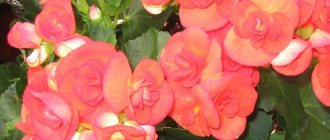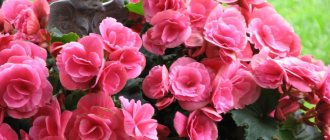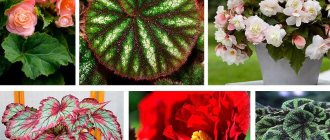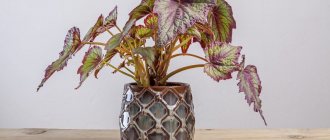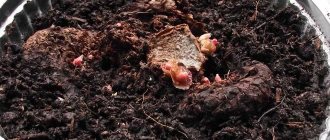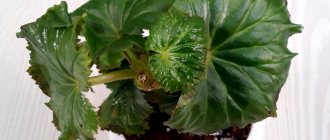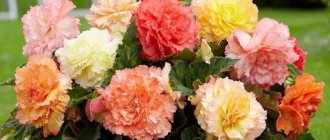Begonia belongs to the most famous and numerous genus of the family of the same name. This genus unites approximately 1 thousand species of various plants, which under natural conditions can be found in the mountains, and they prefer to grow at an altitude of 3-4 thousand. meters above sea level, they are also common in tropical rainforests and subtropics. In this article we will look at the types of indoor begonia and photos with names.
Among begonias there are annual and perennial herbs, shrubs (occasionally climbing) or subshrubs with a creeping or tuberous-thickened rhizome, sometimes with a tuber. The leaves are usually asymmetrical, often beautifully colored (especially in cultivated species). The flowers are irregular, mostly unisexual, monoecious. Tepals are unequal, brightly colored; fruit - capsule.
A well-developed root system of begonia can be branched, fibrous or tuberous. Begonia, which has a root in the form of tubers, can be grown not only indoors, but also in the garden. Other types of begonia are grown only at home.
The Antilles are considered the homeland of begonia. The plant was discovered there at the end of the 16th century by participants in one of the scientific expeditions organized by Michel Begon. Subsequently, unknown at that time plants were named after him, found and described by the botanist from France Charles Plumier, who also participated in this trip.
Today there are a lot of hybrid forms of begonia in modern floristry. Depending on their decorative qualities, there are decorative deciduous and decorative flowering varieties. There is another classification, according to which varieties of incredible flowers are divided into three categories:
- leafy (propagation by roots);
- bush (propagated by seeds and apical shoots);
- tuberous (planted with tubers).
Tuberous begonias
Begonia Picotee Harlequin (Picotee)
Picoti Harlequin is a type of tuberous begonia. It differs from other representatives of this species by the special two-color color of its inflorescences. During flowering, which begins in late spring and ends in mid-autumn, the bush is covered with many large yellow flowers. This is a tuberous begonia, the varieties of which can be seen with photos below.
Begonia Picotee Harlequin is a true miracle of nature. The petals are yellow with a graceful bright red fringe in tiers, like the scales of cones. The center is bright red, but this is the case when such bright shades do not irritate, but attract attention and only delight. The Pendula begonia flower consists of about 10 petals that gently frame the middle. It often grows not only in apartments and houses, but is also used by florists to decorate wedding celebrations.
Begonia Bud de Rose
Begonia Bouton de Rose is a whole group of rose-shaped varieties. The bush is compact, approximately 25 cm high, the leaves are green, and the flower is double, pink, about 18 cm in diameter. Looks good in flower beds and vases. The large-flowered tuberous plant with double pink flowers and white petals edged with bright pink attract novice florists. At the center of the flower is a group of petals resembling a rosebud, hence the name.
During the flowering period, from June to the end of October, it emits a pleasant light aroma. Grows well in partial shade. It will become a real decoration of any flower bed, mixborder, and looks great in group plantings or in balcony boxes as a potted plant. At the same time, “Rose Bud” is a moisture-loving plant, but does not tolerate excess moisture. Water generously in the summer months and sparingly in the winter. You need to maintain stable air humidity and temperature throughout the year.
Duck Red (Begonia DarkRed)
Begonia DarkRed is a low-growing bush with spreading stems and large, finely toothed green leaves, a perennial tuberous plant. The double dark red flowers of this variety of begonias do not exceed 10 cm in diameter and resemble a peony. This is a polyhybrid species that appeared as a result of crossing several species of begonias.
Modern varieties of tuberous begonias are very decorative, hardy plants; depending on the variety, the height of the bush ranges from 18 to 80 cm. The stem is succulent and translucent. This is a fairly large plant, so it needs space. However, in a large hanging basket or other large container, you can create arrangements with different varieties of hanging begonias.
This begonia is ideal for window nurseries and hanging baskets. You can also plant the plant directly in the ground in May, after the frost has passed. Dark Red does not like direct light and morning sun.
Description of the plant
In the seventeenth century, in the Antilles, the French botanist monk Charles Plumier discovered 6 beautiful flowers that had similar characteristics. The scientist described them and united them into one genus, which he named after his friend - the governor of the French colonies (the island of Haiti) and the quartermaster of the French fleet, Michel Begon.
In modern botanical science, Begonia is a genus of plants represented by perennial and annual herbs, subshrubs and shrubs of the Begoniaceae family.
1,600 species of begonias have been discovered in nature, from which more than 2,000 varietal hybrids have been bred.
Begonias grow in humid plains and tropical highlands. Research has shown that although begonias grow all over the planet, their original homeland is the African continent.
Begonias are characterized by bright foliage of asymmetrical shapes, a variety of shapes and colors of flowers, which, after withering, produce a fruit in the form of a seed capsule. The sizes of plants depend on the species and are presented in the range from 30 cm to 2 meters.
Begonia everblooming and its types
Baby Wing
"Baby's Wing" is a large bushy plant with green leaves and single and bicolor flowers of varying colors. This variety series is represented by large and strong bushes, has green and bronze leaves, monochromatic and bicolor flowers of various shades. A rather unique species that attracts most gardeners and florists with its unique leaf shape.
Ambassador
Begonia evergreen (ambassador mix) has become one of the most popular plants for flower gardens recently, although it was originally an indoor plant. This success was facilitated both by begonia’s own qualities and by the intensive work of breeders, which made it possible to create a wide variety of forms, varieties and hybrids. This is an early begonia with green leaves 20-25 cm high.
The plants are fast-growing, perennial, but are mainly grown as annual houseplants. The bushes are quite compact. The leaves are shiny green, the flowers are large (3 cm in diameter), located just above the leaves. A large palette of bright colors, very early flowering (blooms 10-11 weeks after germination) attracts many breeders.
This type can be in the following colors: Bicolor (white with pink edge), Coral (coral), Pink (pale pink), Rose (hot pink), Rose Blush (pink blush), Scarlet (bright red), White ( white).
This begonia reproduces well by various types of vegetative propagation - cuttings, leaves, division, and by seed.
Gloire de Lorraine
Lorrain - a hybrid of Begonia socotrana and B.dregei - is a uniquely beautiful hanging plant for moderately warm rooms. Its thin shoots, drooping with age, reach 50-60 cm and are covered almost all year round with a mass of rather large pink flowers with numerous yellow stamens. The flowers are dioecious, the female flowers are larger, with a triangular ovary. Seeds, as a rule, are not formed.
The flowering period of this plant is from November to March, and the color is very abundant, a large number of buds are collected in inflorescences. (If the plant does not bloom, read our article) A well-lit place is suitable for placing this indoor plant, but keep in mind that direct sunlight leaves cause burns, so this arrangement must be avoided, otherwise the plant may die. Blooming begonias, their photos with names are presented below.
Similar articles:
Mallorca pelargonium - a detailed description of popular...
Review of the most popular indoor plants with…
Alyssum: description of popular species, features...
Deciduous begonias
Royal (Rex)
Royal is a hybrid variety of begonia. It is a perennial herbaceous plant that is native to the northeastern state of India called Assam. It enjoys great recognition among gardeners because Rex is an unpretentious plant with fairly simple care. Its other names are “Napoleon’s ear” or “elephant ears” (folk names). Most plants are low, reaching a maximum of 1-1.5 m, with a lodging, creeping, and eventually hanging stem, which is a rhizome.
The Royal species has a small stem and creeping root, the leaves have a varied color - from green to burgundy, and are covered with short hairs. The variety of leaf shapes, as well as their beauty, more than make up for the lack of flowering. The leaf blade is velvety, slightly pimply, with convex red veins on the reverse side. The result of crossing within and with other types of begonias has become unusual varieties and hybrids with spirally twisted or fringed leaves, bright scarlet colors, contrasting stripes, and inclusions. Royal begonia is an ornamental plant; it has no flowers.
Metallic Begonia (Metallica)
Begonia metallic belongs to the decorative deciduous species of begonias. The flower got its name due to the shade of the leaves: on the back they are purple, but on the front they are green with red veins and a metallic tint. The upper side of the leaf plate has a metallic sheen, the lower side has a red tint. The stems and leaves are generously covered with bristles. It blooms with small white or pinkish flowers from spring to autumn. The outer side of the petals has fluffy reddish hairs. This is an ornamental begonia.
Metallic begonia does not tolerate stagnant moisture in a pot: the root system may rot. Also, metallic begonia does not withstand dry soil. It must be watered moderately, and most importantly - systematically. Recommended for growing in bright, warm and cool rooms, halls; it grows well even on the northern windows of cold greenhouses.
The flowers are whitish, covered with pink hairs, unisexual. Male flowers predominate with four tepals, two of which are outer, almost round, up to 1.3 cm long.
Tiger begonia
Tiger begonia (or Bauer begonia) is an indoor ornamental plant that attracts the attention of gardeners with its exquisite beauty, low maintenance requirements and compactness of the bush. Despite its decorative nature, the tiger species also blooms with small white flowers in winter. But many gardeners remove them so that the plant gives all its strength and nutrition to the leaves. Do the same with old leaves. However, in indoor conditions, the plant, which is considered predatory, has a completely gentle character and easily adapts to many unfavorable conditions. This is another deciduous begonia (types, photos and names can be seen below).
There is no above-ground stem; a long drooping leaf grows directly from the root system. The height of the bush is up to 30 cm. In winter, a long flowering stem grows, on which white flowers are formed. Tiger begonia loves shade and partial shade, but in no case a place exposed to the sun. She feels great when the temperature exceeds 10 °C.
Cleopatra
Begonia Cleopatra prefers bright places; large leaves need photosynthesis, but must be protected from direct sunlight. This is an indoor plant that prefers warm rooms; it is recommended to place it on east or west windows. A lover of diffused, saturated light, Cleopatra begonia or American maple has olive-colored leaves and an erect, branching stem. The leaves are brown on the inside, and the leaf blades are covered with small light hairs. The maximum plant length is about 35 cm.
Begonia variety Cleopatra should be watered abundantly in summer, and moderately on cool days. Loves begonia and warm showers. Specific requirements of this species: does not like direct spraying. To humidify the air, it is necessary to pour water into a separate tray; in spring and summer you need to shade; For proper formation of the bush, it is advisable to rotate it periodically.
Loves moderate moisture
The initial growth of begonia in tropical conditions gives reason to think about creating a thematic climate for indoor growth.
The conditions for keeping the heroine of the topic are as follows:
- Temperature – plus 15-25 degrees Celsius;
- Air humidity – 60-70%;
- Ventilation – moderate;
- Lighting level – partial shade or diffused.
It is recommended to water begonia immediately after the top layer of soil has completely dried. And if from May to October the sky envelops the flower in heat, then the air must be humidified with a spray bottle. Then, already in the third or fourth year from the moment of planting, the large begonia pleases the eye.
Varieties
In total, about 120 species of begonia have been bred, some of them are the most ancient, others appeared over time and not without the help of experienced breeders. In any case, this ornamental plant can decorate the front yard, a flowering garden and become an attractive decorative element in the house.
Tuberous begonia
It is one of the most unpretentious species, distinguished by beautiful and lush flowering. Thanks to these advantages, buyers most often buy this type of flower. The petals of these varieties are distinguished by their velvety quality and a variety of shades from the lightest to deep burgundy.
Gardeners recommend buying plants whose buds have not yet fully opened, with evenly colored petals without spots. Tubers should be small, elastic, tightly collected, not falling apart and free from stains of any kind.
This type works best in flower beds, decorative areas, and balconies.
Beautifully blooming
Sometimes she is called “Maiden Beauty”. It is characterized by fast growth and bright lush inflorescences. It is a low bush with grassy shoots and leaves of all shades of green. Small notches form on the edges of the leaves.
The flowers are small, most often white, pink or purple. Their shape is quite simple and does not differ in intricate configurations. These species are not at all afraid of dry air, so they feel great both at home and outside in cold weather. For flowering, they need 13-15°C and rare watering.
Royal
It is distinguished not so much by its beautiful flowers as by its decorative leaves. Breeders who breed this plant have created many variations of unusual leaf shapes of all sizes. The surface of the leaves can have any patterns: white, pink, silver shades with veins, spots, stripes. The variety of varieties of this species is great; any gardener will be able to decorate their flower beds with unusual decorative flowers.
Bush
They grow quickly, bloom brightly, forming many inflorescences and leaves of all shapes and colors. The flowers are quite large and noticeable.
The bushes grow up to 3 meters in height, but there are also smaller representatives - up to 20 cm. As for indoor cultivation, these are the most resistant plants to the home climate. Most often, bush species grow straight, but there are also cascading varieties that can decorate a patio or vertical composition.
The flowers are characterized by an expressive, but not intrusive, pleasant aroma.
